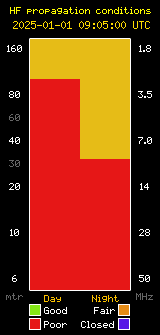Written by John Berry, GM8JBJ
Many members will remember the phone patch - the forerunner of mobile phones.
In one example, ships at sea would call Portishead Radio on HF and ask to be connected to a landline number. Once the landline subscriber answered, the ships radio service operator would flick a switch and a husband would talk to his wife, or captain would talk to his or her port agent. It was an essential service.
In another, an Aircall, Securicor or BT - mobile user would selcall their service operator. On answering, the mobile user would request connection to a landline. When the landline subscriber answered, the operator would flick a switch and connect the two. Aircall and Securicor were simplex. BT was duplex and a forerunner of our present mobile networks.
Now, fast forward to today.
In a pre-CoVid world, Scouts could talk to other Scouts via amateur radio on the third weekend in October each year. Jamboree On The Air is an ad-hoc event that stems from cooperation between local Scouts and radio amateurs. During JOTA, amateur operators set up calls and pass the mic to a Beaver, Cub, Scout or Explorer. Those Scouts pass ’greetings messages’ to other Scouts elsewhere in the UK or worldwide.
Then came CoVid.
Jamboree On The Air this year was held from Friday 16th to Sunday 18th October. At the time, and in most areas, Scouts were at what they refer to as Readiness Level Yellow. Small scale face-to-face activities were allowed, but everyone attending had to be socially distanced. These constraints precluded traditional JOTA operation with the amateur operator sitting beside the Scout. New methods of operation needed to be found.
So, Scouts and their radio amateur partners perhaps needed to take a leaf from the days of phone patch.
Here’s the solution using the likes of Zoom that Borders District Scouts used at the special event station GB2SBS run by John, GM8JBJ and Sue, MM3SLB.
 The connection between Zoom and HF is made using an XGGcomms digital interface containing a C-Media CM108 chipset sound card for digital-to-analogue conversion. The interface links the USB socket of a Raspberry Pi running a Zoom session to the HF transceiver 13-pin facilities socket. Normally digital interfaces use a sub-carrier VOX to key the transmitter. An interface was introduced to disable the VOX and add a manual PTT and this box is shown (light grey) in the adjacent picture.
The connection between Zoom and HF is made using an XGGcomms digital interface containing a C-Media CM108 chipset sound card for digital-to-analogue conversion. The interface links the USB socket of a Raspberry Pi running a Zoom session to the HF transceiver 13-pin facilities socket. Normally digital interfaces use a sub-carrier VOX to key the transmitter. An interface was introduced to disable the VOX and add a manual PTT and this box is shown (light grey) in the adjacent picture.
The ’DATA’ position connects the digital interface for digi-modes use and is the pass-through state. The ’PATCH’ position interrupts the VOX and enables the ’TX KEY’. The TX KEY connects Zoom to HF - the ’patch’ state - and keys the transmitter. The interface uses two two-pole on-on switches and a lead and some wiring. On receive, the audio is routed through the interface to the Raspberry Pi audio and on to Zoom.
John, GM8JBJ, was radio operator while Sue, MM3SLB, acted as ‘Zoom’ controller. In fact, GoToMeeting was used (rather than Zoom), but the solution is common to all online meeting platforms. The voice quality of ‘Zoom’ participants was excellent in both directions.
For anyone wanting to set such a system up for JOTA, there are some points to note.
The radio operator must join the Zoom meeting using the PC with the interface. In my case, I used a Raspberry Pi with a camera pointing at the rig so that the young people on Zoom would be able to see the rig and its settings.
Part of JOTA is also generally to work on, and complete, the Communicator Activity Badge when the young people must log 25 stations. Several must therefore be on the Zoom call simultaneously, listening to on-air proceedings for a few hours.
The radio operator must also join the Zoom meeting with a separate PC with headset and mic so that they can talk to the Zoom controller. The Zoom controller can then also hear the on-air proceedings, and hence they know when to tell the young person to go ahead. If this link is missing, the Zoom operator is working blind.
Having three independent on line meeting connections over one broadband circuit does tax the broadband capability, though!
And radio and Zoom operators must of course be in separate rooms to avoid howl round.
Then Scouts join the Zoom call as normal and talk over HF in turn.
Simples! And it worked perfectly.
And the results? 26 QSOs with stations in 18 countries over 10 hours. 10 Scouts participated for about 4 hours each. Another 10 or so stations were heard and logged, including V55JOTA, in Namibia, though conditions faded before contact could be made. Our Scouts passed 15 ’greetings messages’ or patches. And since all had completed a training session beforehand, all will now get their Communicator Activity Badge. The training session was effectively a slimmed down Foundation Course.
The best DX was KA8OFC, Michigan with second place to VY2GF, Prince Edward Island. Best QSO was LX9S, Scouts World Bureau, in Luxembourg.
And the icing on the cake for one of our Scouts was when CR7ARW videoed her greetings message being received and sent us the recording.
JOTA this year was a much-muted affair. Sole operators lamented that they were unable to have any participation with their Scouts. Unfortunately, GB2BS seemed to be the only station who could put Scouts ‘on-air’. We were the only station who thought ahead to use the phone patch concept.
Perhaps more radio amateurs will make connection possible next year.
John Berry, GM8JBJ



